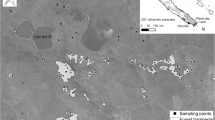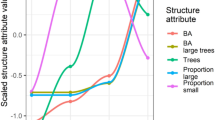Abstract
Tree presence in semiarid ecosystems is generally constrained by insufficient annual rainfall. However, in semiarid Chile, rainforest patches dominated by Aextoxicon punctatum are unexpectedly found on coastal mountaintops (450–600 m) at 30°S, surrounded by a xerophytic vegetation matrix that receives only 147 mm of annual precipitation. It has been proposed that these forests persist as a result of fog-water inputs. If so, then because fog-water deposition is spatially heterogeneous and shows strong edge effects, the potential environmental gradient created by the direction of fog input should determine forest structure and tree regeneration patterns. To investigate this hypothesis, we measured fog inputs, forest structural attributes (age and size distribution, basal area, and coarse woody debris), and tree regeneration in three different habitats: the windward edges (WE), leeward edges (LE), and the interior (center) of rainforest patches varying in area from 0.2 to 22 ha. Mean fog-water input was estimated from passive collectors over 1 year in WE and LE of patches. Tree regeneration was greater in the WE and forest interior (FI) and decreased toward the LE of patches, following a marked pattern of decline in fog inputs. Older trees and coarse woody debris were concentrated in the FI and LE of patches. Tree regeneration and patch structure appear to be largely controlled by fog-input direction and edge effects. We propose that forest patches may be slowly growing toward the incoming fog edge, while dying at the opposite edge.




Similar content being viewed by others
References
Armesto JJ, Fuentes ER. 1988. Tree species regeneration in a mid-elevation temperate forest in Isla Chiloé, Chile. Vegetatio 74: 151–159
Armesto JJ, Aravena JC, Villagrán C, Pérez C, Parker GG. 1996. Bosques templados de la cordillera de la costa. In: Armesto JJ, Villagrán C, Kalin-Arroyo MT, Eds. Ecología de los bosques nativos de Chile. Santiago: Editorial Universitaria. p. 199–233
Azevedo J, Morgan DL. 1974. Fog precipitation in coastal Californian forests. Ecology 55:1135–41
Beier C, Gunderson P. 1989. Atmospheric deposition to the edge of a spruce forest in Denmark. Environ Pollut 6:257–71
Burgess N, Dawson TE. 2004. The contribution of fog to the water relations of Sequoia sempervirens (D. Don): foliar uptake and prevention of dehydration. Plant Cell Environ 27:1023–34
Carmona M, Armesto JJ, Aravena JC, Pérez C. 2002. Coarse woody debris biomass in successional and primary temperate forests in Chiloé Island, Chile. Fort Ecol and Manage 164:265–75
Cereceda P, Schemenauer RS. 1991. The occurrence of fog in Chile. J Appl Meteorol 30:1097–105
Cereceda P, Osses P, Larrain H, Farías H, Logos M, Pinto R, Schemenaver RS. 2002. Advective, orographic and radiation fog in the Tarapaco region, Chile. Atmos Res 64: 261–271
Cottam G, Curtis JT. 1956. The use of distance measures in phytosociological sampling. Ecology 37:451–60
Dawson TE. 1998. Fog in California redwood forest: ecosystem inputs and use by plants. Oecologia 117:476–85
Di Castri F, Hajek E. 1976. Bioclimatología de Chile. Santiago: Universidad Católica de Chile
Duncan R. 1989. An evaluation of errors in tree age estimates based on increment cores in kahikatea (Dacrycarpus dacrydioides). N Z Nat Sci 16:31–7
Erisman JW, Draaijers G, Duyzer J, Hofschereuder P, van Leeuwen N, Romer F, Ruijgrok W, et al. 1997. Particle deposition to forests: summary of results and application. Atmo Environ 31:321–32
Gajardo R, Grez I. 1990. Diagnóstico de algunos aspectos de la regeneración en el bosque de Fray Jorge (IV Región). La Serena: Ministerio de Agricultura — CONAF IV Región
Gajardo R, Toral M, Cubillos V. 1984. Estudio de regeneración en el bosque de Fray Jorge. La Serena: CONAF IV Región — Universidad de Chile, Facultad de Ciencias Agrarias, Veterinarias y Forestales
Grace J. 1997. Plant–water relations. In: Crawley MJ, ED. Plant ecology. Oxford, (UK): Blackwell Science. p 28–50.
Heinemann K, Kitzberger T, Veblen TT. 2000. Influences of gap microheterogeneity on the regeneration of Nothofagus pumilio in a xeric old-growth forest of northwestern Patagonia, Argentina. Can J For Res 30:25–31
Heinz V. 1998. Holocene changes and atmospheric paleocirculation in the northwestern part of the “Arid Diagonal” of South America. Bamberger Geographi Schr 15:355–369.
Holdridge LR. 1947. Determination of world plant formations from simple climatic data. Science 105:367–8
Hutley LB, Doley D, Yates DJ, Boonsaner A. 1997. Water balance of an Australian subtropical rainforest at altitude: the ecological and physiological significance of intercepted cloud and fog water. Austr J Bot 45:311–29
Jaksic F. 2001. Ecological effects of El Niño in terrestrial ecosystems of western South America. Ecography 24:241–50
Kitzberger T, Steinaker DF, Veblen TT. 2000. Effects of climatic variability on facilitation of tree establishment in northern Patagonia. Ecology 81:1914–24
Kummerow J. 1966. Aporte al conocimiento de las condiciones climáticas del bosque de Fray Jorge. Boletín técnico. Santiago: Universidad de Chile, Facultad de Agronomía p 21–4
Looser G. 1935. Argumentos botánicos a favor de un cambio de clima en Chile central en tiempos geológicos recientes. Rev Univ 20:843–57
López-Cortés F, López D. 2004. Antecedentes bioclimáticos del Parque Nacional Bosque Fray Jorge. In: Squeo FA, Gutiérrez JR, Hernández IR, eds. Historia natural del Parque Nacional Bosque Fray Jorge. La Serena (Chile): Universidad de La Serena. p 45–60
Loveless AR. 1961. A nutritional interpretation of sclerophylly based on differences in the chemical composition of sclerophyllous and mesophytic leaves. Ann Bot 24:168–76
Maldonado A, Villagrán C. 2002. Paleoenvironmental changes in the semiarid coast of Chile (∼32°S) during the last 6200 cal years inferred from a swamp–forest pollen record. Quat Res 58:130–8
Maticorena C, Quezada M. 1985. Catálogo de la flora vascular de Chile. Gayana Bot 42:1–157.
McCulloch RD, Bentley MJ, Purves RS, Hulton NRJ, Sugden DE, Claperton CM. 2000. Climatic inferences from glacial and palaecological evidence at the last glacial termination, southern South America. J Quat Sci 15:409–17
Meserve PL, Kelt DW, Milstead WB, Gutiérrez JR. 2003. Thirteen years of shifting top-down and bottom-up control. Biol. Science 53:633–46
Montecinos A, Aceituno P. 2003. Seasonality of the ENSO-related rainfall variability in central Chile and associated circulation anomalies. J Clim 16:281–96
Muñoz C, Pisano E. 1947. Estudio de la vegetación y flora de los parques nacionales de Fray Jorge y Talinay. Agric Técn 7:71–190
Novoa-Jerez J, Viada-Ovalle JM, López D, Squeo FA. 2004. Localización espacial del bosque Fray Jorge en los Altos del Talinay, IV Región de Coquimbo. In: Squeo FA, Gutiérrez JR, Hernández IR, eds. Historia natural del Parque Nacional Bosque Fray Jorge. La Serena (Chile): Ediciones Universidad de La Serena. p 161–71
Pérez C. 1996. Los procesos de descomposición de la materia orgánica en bosques templados costeros: interacción entre suelo, clima y vegetación. In: Armesto JJ, Villagrán C, Kalin-Arroyo MT, eds. Ecología de los bosques nativos de Chile. Santiago: Editorial Universitaria. p 301–16
Philippi F. 1884. A visit to the northernmost forest of Chile. J Bot 22:202–11
Rundel PW, Mahu M. 1976. Community structure and diversity of a coastal fog zone in northern Chile. Flora 165:493–505
Schemenauer RS, Cereceda P. 1994. Fog collection’s role in water planning for developing countries. Nat Resour Forum 18:91–100.
Schmithusen J. 1956. Die räumliche Ordnung der chilenischen Vegetation. Bonn Geogr Abh 17:1–86.
Skottsberg C. 1948. Apuntes sobre la flora y vegetación de Fray Jorge, Chile. Meddel Góteborgs Bot Trádgard 18:91–184.
Smith-Ramirez C, Armesto JJ, Rodriguez J, Gutiérrez AG, Christie D, Nuńez M. 2005 Aextoxicon punctatum el tique u olivillo. In: Smith-Ramirez C, Armesto JJ, Valdovinos C. Eds. Historia, biodiversidad y ecología de los bosques costeros de Chile. Santiago (Chile): Editorial Universitaria. p 278–283
Squeo FA, Arancio G, Novoa-Jerez J. 2004. Heterogeneidad y diversidad florística del Bosque de Fray Jorge. In: Squeo FA, Gutiérrez JR, Hernández IR, eds. Historia natural del Parque Nacional Bosque Fray Jorge. La Serena (Chile): Ediciones Universidad de La Serena. p 173–85.
Stokes M, Smiley T. 1968. An introduction to tree ring dating. Chicago: Univerisity of Chicago Press
Veblen TT, Donoso C, Schlegel FM, Escobar R. 1981. Forest dynamics in south-central Chile. J Biogeogr 8:211–47
Veblen TT, Markgraf V. 1988. Steppe expansion in Patagonia? Quat Res 30:331–8
Villagrán C, Armesto JJ. 1980. Relaciones florísticas entre las comunidades relictuales del Norte Chico y la Zona Central con el bosque del Sur de Chile. Bol Mus Nac Hist Nat 37:85–99.
Villagrán C, Varela J. 1990. Palynological evidence for increased aridity on the central Chilean coast during the Holocene. Quat Res 34:198–207.
Villagrán C, Armesto JJ, Hinojosa F, Cuvertino J, Pérez C, Medina C. 2004. El enigmático origen del bosque relicto de Fray Jorge. In: Squeo FA, Gutiérrez JR, Hernández IR, eds. Historia natural del Parque Nacional Bosque Fray Jorge. La Serena, (Chile): Ediciones Universidad de La Serena. p 173–85
Weathers KC, Lovett GM, Likens GE. 1992. The influence of a forest edge on cloud deposition. In: Schwartz SE, Slinn WGN, eds. Precipitation scavenging and atmosphere–surface exchange. Washington, (DC): Hemisphere. p 1415–23
Weathers KC, Lovett GM, Likens GE. 1995. Cloud deposition to a spruce forest edge. Atmos Environ 29:665–72
Weathers KC, Lovett GM, Likens GE, Lathrop R. 2000. The effect of landscape features on deposition to Hunter Mountain, Catskill Mountains, New York. Ecol Appl 10:528–40
Weathers KC, Cadenasso M, Pickett STA. 2001. Forest edges as nutrient and pollutant concentrators: potential synergisms between fragmentation, forest canopies, and the atmosphere. Conser Biol 15:1506–14
Acknowledgements
This work was supported by Fondo de investigación Avanzada en Areas Prioritarias FONDAP – FONDECYT 1501-0001 Centro de Estudios Avanzados en Ecologia Biodiversidad (CASEB); the Biocores Project, funded by the European Community (EC) under the INCO IV program (contract ICA 4-CT-2001–10095); Centro Milenio para Estudios Avanzados en Ecología e Investigación en Biodiversidad (CMEB) (PO2-051-F, ICM); the National Science Foundation (International Americas Program, INT-0313927); and the Institute of Ecosystem Studies. The Corporación Nacional Forestal (CONAF, IV Región, Chile) kindly gave permission to work at Fray Jorge National Park. We thank J. Monardes, A. Abarzúa, M. Nuñez, D. Fernández, J. P. François, J. Valdez, J. M. Valenzuela, T. Catalán, N. Davis, and D. Gho for their help with field data collection, and N. Carrasco and A. Rivera for laboratory assistance. Pablo Necochea kindly drew the Fray Jorge map. Other than the first author, order of authorship is alphabetical. This is a contribution to the program of the Institute of Ecosystem Studies.
Author information
Authors and Affiliations
Corresponding author
Rights and permissions
About this article
Cite this article
del-Val, E., Armesto, J.J., Barbosa, O. et al. Rain Forest Islands in the Chilean Semiarid Region: Fog-dependency, Ecosystem Persistence and Tree Regeneration. Ecosystems 9, 598–608 (2006). https://doi.org/10.1007/s10021-006-0065-6
Received:
Accepted:
Published:
Issue Date:
DOI: https://doi.org/10.1007/s10021-006-0065-6




